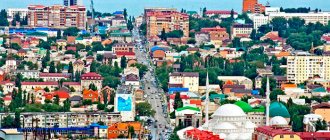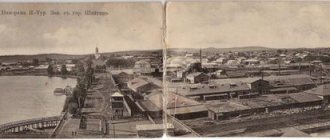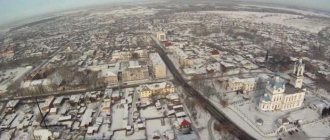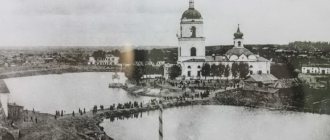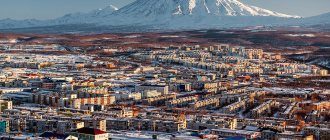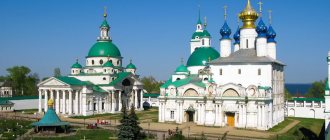History of Revda
The site for the construction of the Revdinsky plant was chosen in 1730. The following year, construction began here. The Revda River was blocked with a dam, factory workshops were erected, and a factory village arose. On September 1, 1734, the Revdinsky plant, founded by Akinfiy Nikitich Demidov, produced its first products - 6 pounds of cast iron. This date is considered the birthday of the city of Revda. Later, upstream the Revda River, another dam was built, near which the Mariinsky Ironworks appeared.
However, people have been here for a long time. Archaeologists have found several sites of ancient man (one of them is on a cape at the confluence of the Chusovaya and Revda rivers). The discovery of three mounds south of Revda is very interesting. In 1898, the mounds were examined by the caretaker of the Revdinsky plant A.M. Kozyrin. During reconnaissance in one of the mounds, he discovered the remains of a man and a horse. Nearby lay a bronze sword and metal parts of a harness. The finds were transferred to the Yekaterinburg Museum. They were dated to the second half of the first millennium BC. In the 18th century, before the purchase of land by the Demidovs and the construction of the plant, this territory belonged to the Bashkirs.
The iron from the Revdinsky plant was famous for its quality and was in demand. The roofs of Westminster Abbey in London were covered with Revdin roofing sheets.
In the spring, factory products were sent in barges down the Chusovaya River to Central Russia. The pond of the Revdinsky plant was of great importance. The release of water from it made it possible to raise the water level in Chusovaya to the level necessary for rafting barges. All factories in the Middle Urals that sent metal along Chusovaya depended on Revda.
In 1774, the Revdinsky plant was captured by the Pugachevites. The residents of Revda greeted them joyfully. “The Revdinsky, Shaitansky, Bilimbaevsky factories were the most villainous nest,” documents from that time reported.
During the First World War, prisoners of war first appeared in Revda. Their first batch was delivered in 1916. In total, during the First World War there were about 2 thousand people here - Austrians, Hungarians, Slovaks. They lived in barracks near the Revda River (now here is the production site of NSMMZ), and worked in auxiliary and menial jobs. 417 prisoners died. The cemetery was located on the site of the modern Avtomobilist collective garden. Now there is a small monument there. 4 officers were buried in the city cemetery, where you can still find graves with signs in German.
Newly captured Germans and Austrians were brought to Revda and Degtyarsk during World War II. They were employed in manufacturing, logging, and building public and residential buildings. In 1955, former prisoners of war were sent home.
In the 20th century, the Yekaterinburg-Kazan-Moscow railway passed through Revda. However, the station was originally called “Kapralovo”, only in 1963 it was renamed “Revda”. The modern station was built in 1980.
Revda received city status in 1935. The city-forming enterprises of Revda: NSMMZ, SUMZ, OCM plant, brick factory.
The population of Revda is 62 thousand people.
"Kabala Springs"
“Kabala Springs” is a unique place a kilometer from the city limits. A wide variety of animals and birds live here. Due to the fact that people often relax at the springs, the squirrels have become almost tame and boldly come out to the vacationers. The streams are equipped with special booths for easy collection of water. The uniqueness of this attraction is that the water in the springs never freezes.
Revolt of the Charcoal Burners
Due to difficult working conditions and the peculiarities of serfdom, worker uprisings broke out more than once at the Revdinsky plant. Unrest in Revda occurred in 1771, 1774, 1800, 1824-1826, 1841 and 1861.
The most famous and, at the same time, most tragic episode in the history of Revda is associated with the largest uprising of coal burners in history, which occurred in the spring of 1841.
In 1841, the coal volume in Revda was significantly larger than at other Ural plants. In October 1840, the factory police officer Zemlyanitsyn received a decree from the Ural Mining Board, which demanded the introduction of a single coal box measure in private factories in the amount of 22,400 cubic vershok (in Revda the measure was 27,216 cubic vershok). Zemlynitsyn, in agreement with the factory owner, hid the document from the workers, but rumors about it still spread. The coal burners demanded that a decree be announced to them, but the police chief told them that there would be no changes at the plant. A few days later, Zemlyanitsyn arrested three coal burners’ attorneys at the Shaitansky plant (now Pervouralsk), who had arrived there with the aim of writing a complaint against the factory management.
Following this, on April 7, 1841, 300 charcoal burners from the village of Krasnoyar came to the police officer. They demanded the release of those arrested and the announcement of a decree to reduce the coal ash rate. The police officer hastened to report what was happening to Yekaterinburg, from where advisor to the mining department Karpov was sent to the Revdinsky plant to restore order. However, the persuasion of the factory police officer, adviser Karpov and priest Dmitry Flerovsky had no effect on the charcoal burners. They refused to work, gathering every day in the factory area. Tension was building among the strikers.
On April 14, two companies of soldiers from Yekaterinburg (178 people) entered Revda. But this had no effect on the charcoal burners either. The strike continued. The military and factory management decided to use weapons...
On the morning of April 15, the charcoal burners again moved to the factory area. But then soldiers came out to meet them from the other end of the square. The workers refused the demand to disperse. After that, the soldiers opened fire...
Armed only with stones and wooden stakes, the charcoal burners rushed at the soldiers. Confused, the military retreated, leaving a cannon in the square. Soon realizing, the soldiers repelled the onslaught. The artillerymen aimed a cannon at the center of the crowd, where the leaders of the uprising were, and fired grapeshot. With a second shot and rifle fire, the charcoal burners were scattered and began to scatter.
The dead and wounded were left lying on the blood-stained square. Colonel Porozov’s report stated that “25 men and 8 women were killed, and 54 men and 8 women were wounded.” In the surviving private chronicle of the Umnovs, other data is reported: “161 men, 6 women, 2 girls of 13 years old and 2 boys were killed.” Many of the wounded died later. The dead were buried in a common grave.
The instigators of the uprising were tried until May 1842. Four leaders of the uprising (Yuvenaly Dryagin, Karp Eremin, Matvey Borozdin, Timofey Kozyrin) were sent to hard labor, 25 coal burners were recruited, 270 convicts were sentenced to flogging from 30 to 50 blows and left at the plant.
In 1922, on the site of the mass grave of coal burners, a cast-iron monument was erected in the form of a worker with a weapon, and in 1933, in memory of the victims of the uprising, Bolshaya Yalan Street was renamed to Outbreakers Street. A monument dedicated to this tragic page in the history of the city also stands on Coal Mountain near the Demidov Center.
Coat of arms and flag
Coat of Arms
In a dissected field of silver and green on a three-peaked mountain of variable colors there is a black bear and a silver sable supporting the sign of iron in the form of a ring of the same variable colors, topped with an ancient arrowhead.
Flag
Main article: Flag of Revdinsky district
The panel with an aspect ratio of 2:3 is divided vertically into two equal parts, white and green, and bears the image of the figures of the coat of arms of the Revda region: a green and white iron sign supported by a black bear and a white sable; The flag has a stripe along the lower edge 1/5 of its height, also divided vertically into two equal parts - green and white.
Sights of Revda
The “heart” of Revda is the dam that gave rise to the plant and the city. On the dam dam there is a monument in honor of the founding of Revda - a high stele, lined with marble. It was installed in 1984, when the city celebrated its 250th anniversary. The inscription on the monument reads: “Here in 1734, in the remote taiga, a dam and an ironworks were built, and the city of Revda was founded.”
The dam is located between two mountains: on the right bank - Sorokovaya (or Lysaya), on the left - Ugolnaya (or Temple).
On Mount Sorokova (Bald) there are small rocks. From the top there is an excellent view of the vast blue expanse of the Revdinsky pond. The city and the factory are clearly visible. By the way, this mountain became Bald only after the construction of the plant. According to the stories of local residents, not so long ago rifle casings came across here, reminiscent of the tragic pages of the city’s history.
A good view also opens from Mount Ugolnaya. V. Golovko in the book “Revda and Degtyarsk” (1970) wrote:
“There is Mount Ugolnaya in Revda. From there the entire city is visible at a glance. Dense forests and mountains surround the wide valley of the Revda River in a dense ring, where it merges with Chusovaya. It seems that the rocky bulk of Mount Volchikha has moved close to the city. The huge Revdinsky pond overflowed for many kilometers. Its mirror surface seems to divide the city into two parts. One of them, the old one, is located near the dam, where the buildings of the Revdinsky hardware and metallurgical plant rose. This is an area where many small wooden houses built before the revolution still exist. But every year there are fewer and fewer of them. They are giving way to new development. On the left bank of the pond there are multi-story light stone houses. This is the new Revda, or “social city”, as Revda residents call this area. Large modern buildings form straight and wide streets that face the shore and crowd out the old buildings.”
On the slope of Coal Mountain there is an old wooden house with a mezzanine - the house of the manager of the Revdinsky mining district, built in 1900. The house is now abandoned. There are extensive cellars underneath.
Next door, on the territory of the factory, there is a stone building, painted blue and used for factory needs. It looks like a remake. However, this is a house with a rich history - the remains of the former, once luxurious Demidov mansion. Only a part of it, the first floors, has survived. Previously, it was a large three-story house with a mezzanine.
Local historian V.M. Slukin assumed that these buildings were connected by underground passages. He wrote in the book “Secrets of the Ural Dungeons”:
“In the last years of the past 20th century, enthusiasts began to excavate and clear the premises of the buried first floor of the Demidov manor house and the basements of the factory manager. New vaulted rooms with mysterious bookmarks, strange dead ends, with devices reminiscent of smelting forges, and other manifestations of construction thought that have not yet been solved have opened up. Even a cursory examination of the basements, as well as an analysis of the development of the territory and the entire experience of the Demidov world order, allowed us to assume that there are “nests” in the underground space of this site, but it is not yet possible to detect them due to the complex surface situation in the areas promising for search.”
At the top of Coal Mountain stands a modern glass and concrete building with a rectangular tower. This is the Demidov Center museum complex - perhaps the main attraction of the city. The museum, opened in 2007, tells the history of the Demidovs, the city of Revda, and displays antiques and photographs. You can also see in it the only surviving cast-iron mooring pillars, which in the 19th century stood along the banks of the Chusovaya River for mooring barges.
It’s also very interesting near the walls of the Demidov Center. A memorial complex dedicated to the Revda recruits of 1812 (with a cannon), as well as participants in the charcoal burners' performance of 1841, was created here. A little to the side among the grass you can see ancient gravestones. Factory machines are also represented on site. There is an observation deck overlooking the Revdinsky pond.
Next door there is a recreated temple, consecrated in the name of Archangel Michael (a remake on the site of one blown up in Soviet times).
Under the mountain, on the territory of the Rodnichok sanatorium, you can see the so-called energy pyramid of Alexander Golod, 11 meters high. It appeared here in 2004, brought from the Nizhniye Sergi resort-sanatorium.
500 meters to the west is Elansky Park, in which there is a memorial stone with the inscription “In memory of the founder of the city, Akinfiy Demidov.” In summer, flowers are planted here, and the square turns into a place of relaxation.
And on the shore of the pond there is the Elansky Bridge. In the past, the Kureyka River flowed into the Revdinsky Pond in this place. In the 1970s and 80s, the river was filled up, creating Elansky Park in its place and building houses. Now the only thing that reminds us of it is a small swampy lake near the bridge. Previously, one of the first streets of the factory village began from this bridge.
One of the most beautiful places in Revda is in front of the NSMMZ plant management building (Karl Liebknecht St., 3, north of Ugolnaya Gora). There is an exhibition “Iron Fountain” and a metal openwork lattice.
In Revda there is also a typical Stalinist House of Culture (DK SUMZA) with huge columns, behind which there is a park. In the park there is a monument to Komsomol member Pavel Zykin. The inscription on it reads: “Pavel Zykin, an active participant in the construction of the Sredneuralsk copper smelter, was brutally killed by enemies of the people on August 12, 1935.” One of the city streets is also named in his honor.
UPD. The monument was moved to school No. 2.
Not far from the cultural center there is a microdistrict (within the boundaries of Karl Liebknecht, Gorky, Engels and Sportivnaya streets), nicknamed by local residents the “noble nest”. In the past, the city authorities lived here. On the street Engelsa, 54 there is a grocery store with the same name.
In front of the house st. Maxim Gorky, 16 there is a nice Literary Square.
There is a monument to the writer Maxim Gorky there.
Nearby on the street. Maxim Gorky is the first apartment building in Revda with a memorial plaque.
And near the intersection of the street. Engels and Tsvetnikov, if you look at the old wooden power line pole, you will see that it is strengthened by an iron rail with the inscription “1925. VI. Hope. head N.N.”
The monuments in Revda are quite traditional, there are no unique or creative ones here (I would like to believe that there are none yet). On Victory Square there is a monument to V.I. Lenin. Unlike many other monuments to Lenin, he does not point the right path with his hand, but stands sadly with his hands down.
There is also a monument to internationalist soldiers in Revda.
And nearby, on the same Alley of Internationalists, there is a memorial stone to the Revda liquidators of the Chernobyl accident.
Away from the center of Revda, on the right bank of the Revda River, you can see the Holy Trinity Church. And 200 meters from it, against the backdrop of the factory, stands a small wooden chapel of St. Nicholas the Wonderworker.
Another attraction of Revda is the Kabalinsky springs, which are a natural monument. They are located in a small forested area in the southern part of the city. They are named after Mikhail Kabalinov, who in 1862 dammed the Emelina River flowing here, built a nail shop, a forge and a residential building. The Emelina River, 7.5 kilometers long, originates at the foot of the eastern slope of the Shaitansky Uval ridge.
There are four equipped springs, to which there is a paved path from Rodnikova Street. Nearby is a cottage community nicknamed the “Field of Miracles.”
Just above the springs is the Kabalinsky pond, below which a small waterfall forms. Fishermen catch crucian carp and tench in the pond. And in 2015, a 74-year-old fisherman caught a miracle fish half a meter long here. It turned out to be a piranha. Apparently, the exotic fish was released here from an aquarium.
"Church of the Life-Giving Trinity"
In a picturesque place there is a charming Orthodox shrine - the “Church of the Life-Giving Trinity”. The unusual three-story temple building is painted soft blue. The interior of the church is also interesting, distinguished by its unusual design of the walls and ceiling. The temple has a considerable territory, which allows it to accommodate a large number of believers.
Location: Demyan Bednogo street.
Map of attractions
1 - Railway railway station; 2 - bus station; 3 - “Noble Nest”; 4 — DK SUMZ; 5 — rails of the Nadezhda plant; 6 — Literary square with a monument to M. Gorky; 7 - monument to V.I. Lenin; 8 - Alley of Internationalists; 9 - Kabalinsky springs; — 10 — Kabalinsky pond on the river. Emelina; 11 — Elansky Park with a memorial stone in honor of Akinfiy Demidov; 12 - Elansky Bridge; 13 - NSMMZ plant management; 14 - temple in the name of the Archangel Michael; 15 — museum complex “Demidov-Center” on Ugolnaya Mountain with monuments in the adjacent territory; 16 - house of the plant manager and the Demidov estate; 17 - pond dam and stele in honor of the 250th anniversary of Revda; 18 - Mount Sorokovaya (or Bald); 19 — chapel of St. Nicholas the Wonderworker; 20 - Holy Trinity Church.
"Church of St. Michael the Archangel"
The “Church of the Archangel Michael” greets believers with its white walls and golden dome. Divine Liturgies are held daily in this shrine. The upper temple fascinates with the beauty of its five-tiered iconostasis; skillful frescoes suggest certain thoughts. In the lower church there is a baptismal place, and on the belfry nine bells make unique sounds, the heaviest of which weighs more than a thousand kilograms.
Location: Club Lane - 1B.
Neighborhood of Revda
The border between Europe and Asia runs nearby. Near Revda there are several monuments dedicated to this. Due to its proximity to the border of two parts of the world, Revda is sometimes called “the first city of Europe” (although Pervouralsk also claims this).
On Mount Karavashka near the Volchikha Reservoir you can find the former quarries of the Petrovsky silicate-nickel ore mine. Two new minerals were first discovered here, in honor of Revda in the 19th century they received the names revdinskite and revdinite.
In the vicinity of Revda there are many interesting natural attractions: mountains Volchikha, Kamennaya, Yelchevochnaya, Shunut-kamen, the source of St. Platonida, Volchikha reservoir. The neighboring town of Degtyarsk is also worth a visit.
Rock "Old Man Stone"
From the rock “Old Stone” a charming panorama with stunning natural views opens up. The mountain itself received this name due to its stunning resemblance to the old man. In its outline the figure of an elderly man is clearly defined.
The shales and pebbles that make up the rock are over six hundred million years old. Thanks to its beauty, the “Old Stone” has become a favorite place not only for tourists and vacationers, but also for cinematographers, who quite often film various scenes here.
How to get to Revda?
The city of Revda is located in the Sverdlovsk region, 47 kilometers west of Yekaterinburg. The Ekaterinburg-Perm highway runs nearby. The Yekaterinburg-Kazan-Moscow railway runs through the city.
You can get to Revda by train Ekaterinburg - Druzhinino. There are regular buses from the Northern Bus Station.
Pavel Raspopov
See also:
- Old photographs of Revda and the Revda plant
- About a lightning strike at the Revdinsky plant (1892)
- Museum complex "Demidov-Center" in Revda
"Geological Museum"
An excursion to the Geological Museum will be interesting and educational. Here they will tell you in an accessible way about the uniqueness and richness of the Earth's interior. The collections of minerals, minerals and rocks will surprise you with their scale. The museum's collection includes more than forty thousand exhibits. In addition to excursions, museum staff conduct scientific work and conduct thematic lessons and lectures.
Location: Tchaikovsky street - 27.
Media and Internet providers
City sites
City portal "Revda of the Russian Federation" Revda-RF.ru News, directory of organizations, free notice board, free legal assistance, background information, transport schedules, posters and much other interesting, useful information. Founded in 2013
Newspapers
The following newspapers are published in the city:
- “City News” (since 1994, MG “City News” LLC). Release days: Wednesday and Friday. Current news, videos and discussion of articles on the newspaper’s online information portal www.revda-info.ru.
- Advertising newspaper "Stuka". Release days: Monday.
- “Information Week” (since 2007, “Unity Plus”). Owned by UMMC.
- “Absolute info” has been published since 2015 twice a month, circulation 5000 copies. Belongs to the real estate agency "Absolut"
Radio
Radio Miami
- a station with completely its own programming. Operates since 2008 at a frequency of 94.0 MHz. The radio station broadcasts contemporary music for an audience of 16-25 years old (CHR/Dance). There is a weather forecast every hour, local news is broadcast on weekdays, the first episode is at 9:00. Until 2012, the station was the only one in the city, it was actively developing and participating in the life of the city (it even had its own city holiday - “Orange Youth Day”). Currently, the program is produced by one presenter and an experienced journalist. The only program that has been aired regularly and without interruption since its opening is “Gravity.” This is the dance program of DJ Sasha Snake (Alexander Grigorash), on November 4, 2013, the anniversary episode was aired - “Gravity” 5 years old.
Radio Dacha
(Ural Media) operates on a frequency of 94.5 MHz and broadcasts to the cities of Revda, Pervouralsk, Degtyarsk and holiday villages. In addition to the popular federal program, regional blocks are aired: news, weather forecast and a program on request “Lucky Hour”. Target audience: listeners aged 30 - 49 years. The mission of the radio station in the city is not only to broadcast music for adults, but also to increase the interest of residents in the cultural life of the city, as well as to work closely with creative groups and socially active entrepreneurs.
Radio "Interra FM" 97.6 FM - broadcasts to the cities of Revda, Pervouralsk, Degtyarsk.
A television
Cable television "Unity" receives satellite channels. Broadcasting via cable network - more than 50 channels[21]. Unity also began broadcasting TV channels in digital format. List of packages and list of their constituent channels[22]
There is an information program of its own production - “Television News”, which is broadcast on weekdays at 6:00, 12:30, 19:00 and at 23:00. On Saturday - at 12:30. Broadcasting is carried out through the cable network on the federal channel "REN". All stories of the information program, as well as materials from the newspaper “Information Week” are posted on the portal www.revda-novosti.ru
Internet providers
Internet providers providing Internet access services: Interra, Unity, Utel (Rostelecom trademark), K-Telecom, Convex, Beeline



